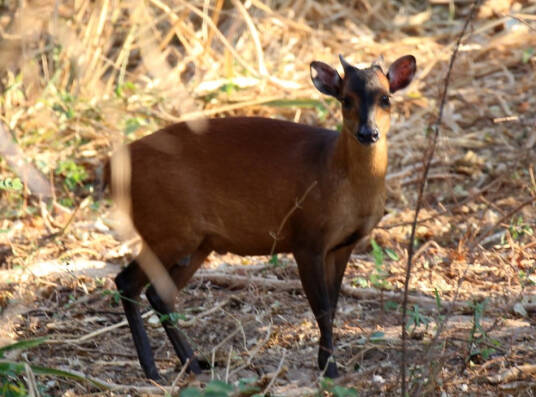Cephalophus harveyi
IUCN
LCBasic Information
Scientific classification
- name:Cephalophus harveyi
- Scientific Name:Cephalophus harveyi,Harbour's gazelle
- Outline:Ungulata
- Family:Artiodactylus Bovidae Gazella
Vital signs
- length:About 78 cm
- Weight:9.4-13.6kg
- lifetime:About 15 years
Feature
There is a black flame line extending from the nose to the eyes to the forehead.
Distribution and Habitat
The Habitat is found in central and southeastern Kenya, northeastern and central Tanzania, southern Somalia and northern Malawi, with a single record in Zambia (2013). In Ethiopia, a single Habitat was found in 1986. The species is also found near the Imatong Mountains, 400 km southwest of South Sudan.
It lives from sea level to 2,400 meters above sea level. It is native to lowland and mountain forests in eastern Africa, mainly in remote forest areas, river forests, and scrub.
Appearance
The head and body length of the Hartebeest duiker is 78 cm, the shoulder height is 41 cm (38.5-47 cm), the tail is 11 cm (8-12 cm) long, and the weight is 9.4-13.6 kg. Females tend to be slightly larger than males. The fur color is generally a bright rich orange-red, with some mountain individuals having darker fur. The legs are dark brown to almost black, with no dorsal stripes. The face is usually red like the body, except for the chin, which is white, and a black flame that runs from the nose, between the eyes and onto the forehead. The forehead is usually completely black, with the middle of the forehead (between the horns) being typically black, but the sides are chestnut red. Both sexes have horns, which are larger in the male, very thick at the base, ridged, and usually 6-9 cm long.
Details
Harvey's Duiker (scientific name: Cephalophus harveyi) English: Harvey's Duiker, East African Red Duiker, Harvey's Red Duiker, French: Céphalophe de Harvey, German: Céphalophe de Harvey, no subspecies.

The Harbour's and Black-fronted Duikers do not have dorsal stripes, and the Red Duiker does not have a black flame on its nose. They can also be distinguished by their body shape, with the Harbour's Duiker having shorter legs, smaller hooves, and smooth fur.
The gestation period of Hartebeest's Duikers is about 210 days. One calf is born per litter. The life span is about 15 years. Little is known about the specific reproductive characteristics of the Harbour's duiker, but the species is probably similar to the Red Duiker. In northern Malawi, newborns have been observed throughout the year (February, March, August and December).
Harbour's duiker species densities range from 2.07-13.32 individuals per square kilometer in forest habitats in the Utsengwa Mountains of Tanzania; 2.4-2.8 animals per square kilometer in the Mwanihana Forest of Tanzania. The species is abundant and is well represented and common in protected areas throughout its range. Although the population has declined, the rate of decline has not yet reached a level that would warrant listing as "Near Threatened" under the IUCN Red List criteria A. However, the long-term survival of Harbour's duiker is increasingly dependent on the maintenance of viable populations within national parks and protected areas, which are effectively protected from habitat destruction and illegal hunting. The total population was estimated at 20,000 in 1999, but this is certainly a significant underestimate.
The main threat to the Habsburg duiker is habitat loss due to timber harvesting and expansion of human settlements, especially in many coastal and montane forests. The Habsburg duiker continues to be heavily hunted by people using dogs and wire snares throughout much of its range. In Somalia, the species was recorded in riverine habitats along the lower Shabelle and Juba rivers and coastal scrub and forest in the Badana Lake region, but by the mid-1980s, they had lost almost all of their habitat along the Juba and Shabelle rivers due to agricultural expansion, surviving only in a few remaining riverine forests along the lower Juba River.
Listed in the IUCN Red List of Threatened Species 2016 ver3.1 - Least Concern (LC).
Protect wild animals and stop eating game.
Maintaining ecological balance is everyone's responsibility!








